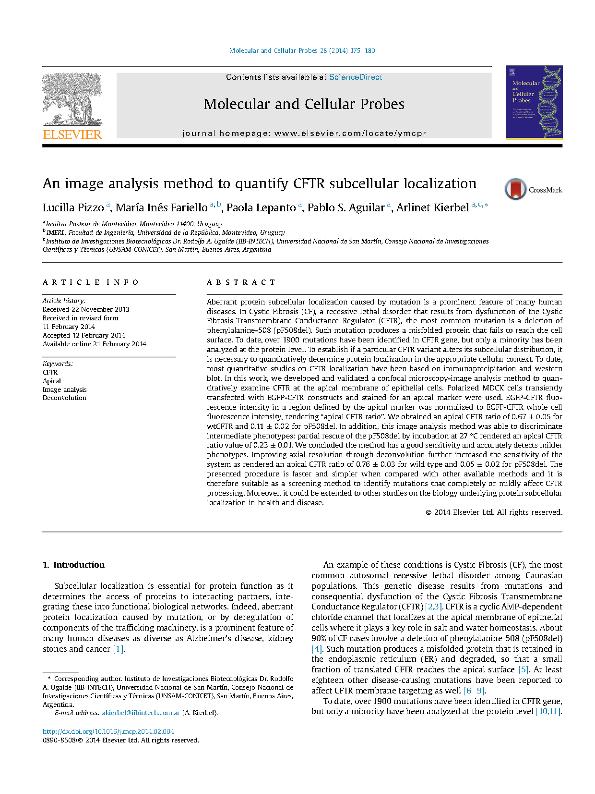Mostrar el registro sencillo del ítem
dc.contributor.author
Pizzo, Lucilla
dc.contributor.author
Fariello, María Inés
dc.contributor.author
Lepanto, Paola
dc.contributor.author
Aguilar, Pablo Sebastián

dc.contributor.author
Kierbel, Arlinet Verónica

dc.date.available
2018-01-04T17:49:42Z
dc.date.issued
2014-02
dc.identifier.citation
Kierbel, Arlinet Verónica; Aguilar, Pablo Sebastián; Lepanto, Paola; Fariello, María Inés; Pizzo, Lucilla; An image analysis method to quantify CFTR subcellular localization; Academic Press Ltd-elsevier Science Ltd; Molecular And Cellular Probes; 28; 2-2014; 175-180
dc.identifier.issn
0890-8508
dc.identifier.uri
http://hdl.handle.net/11336/32324
dc.description.abstract
Aberrant protein subcellular localization caused by mutation is a prominent feature of many human diseases. In Cystic Fibrosis (CF), a recessive lethal disorder that results from dysfunction of the Cystic Fibrosis Transmembrane Conductance Regulator (CFTR), the most common mutation is a deletion of phenylalanine-508 (pF508del). Such mutation produces a misfolded protein that fails to reach the cell surface. To date, over 1900 mutations have been identified in CFTR gene, but only a minority has been analyzed at the protein level. To establish if a particular CFTR variant alters its subcellular distribution, it is necessary to quantitatively determine protein localization in the appropriate cellular context. To date, most quantitative studies on CFTR localization have been based on immunoprecipitation and western blot. In this work, we developed and validated a confocal microscopy-image analysis method to quantitatively examine CFTR at the apical membrane of epithelial cells. Polarized MDCK cells transiently transfected with EGFP-CFTR constructs and stained for an apical marker were used. EGFP-CFTR fluorescence intensity in a region defined by the apical marker was normalized to EGFP-CFTR whole cell fluorescence intensity, rendering “apical CFTR ratio”. We obtained an apical CFTR ratio of 0.67 ± 0.05 for wtCFTR and 0.11 ± 0.02 for pF508del. In addition, this image analysis method was able to discriminate intermediate phenotypes: partial rescue of the pF508del by incubation at 27 °C rendered an apical CFTR ratio value of 0.23 ± 0.01. We concluded the method has a good sensitivity and accurately detects milder phenotypes. Improving axial resolution through deconvolution further increased the sensitivity of the system as rendered an apical CFTR ratio of 0.76 ± 0.03 for wild type and 0.05 ± 0.02 for pF508del. The presented procedure is faster and simpler when compared with other available methods and it is therefore suitable as a screening method to identify mutations that completely or mildly affect CFTR processing. Moreover, it could be extended to other studies on the biology underlying protein subcellular localization in health and disease.
dc.format
application/pdf
dc.language.iso
eng
dc.publisher
Academic Press Ltd-elsevier Science Ltd

dc.rights
info:eu-repo/semantics/openAccess
dc.rights.uri
https://creativecommons.org/licenses/by-nc-sa/2.5/ar/
dc.subject
Cftr
dc.subject
Apical
dc.subject
Image Analysis
dc.subject
Deconvolution
dc.subject.classification
Otras Ciencias Biológicas

dc.subject.classification
Ciencias Biológicas

dc.subject.classification
CIENCIAS NATURALES Y EXACTAS

dc.title
An image analysis method to quantify CFTR subcellular localization
dc.type
info:eu-repo/semantics/article
dc.type
info:ar-repo/semantics/artículo
dc.type
info:eu-repo/semantics/publishedVersion
dc.date.updated
2018-01-03T19:03:56Z
dc.journal.volume
28
dc.journal.pagination
175-180
dc.journal.pais
Estados Unidos

dc.journal.ciudad
New York
dc.description.fil
Fil: Pizzo, Lucilla. Instituto Pasteur de Montevideo; Uruguay
dc.description.fil
Fil: Fariello, María Inés. Instituto Pasteur de Montevideo; Uruguay. Universidad de la República; Uruguay
dc.description.fil
Fil: Lepanto, Paola. Instituto Pasteur de Montevideo; Uruguay
dc.description.fil
Fil: Aguilar, Pablo Sebastián. Instituto Pasteur de Montevideo; Uruguay
dc.description.fil
Fil: Kierbel, Arlinet Verónica. Instituto Pasteur de Montevideo; Uruguay. Consejo Nacional de Investigaciones Científicas y Técnicas. Centro Científico Tecnológico Conicet - La Plata. Instituto de Investigaciones Biotecnológicas. Universidad Nacional de San Martín. Instituto de Investigaciones Biotecnológicas; Argentina
dc.journal.title
Molecular And Cellular Probes

dc.relation.alternativeid
info:eu-repo/semantics/altIdentifier/doi/http://dx.doi.org/10.1016/j.mcp.2014.02.004
dc.relation.alternativeid
info:eu-repo/semantics/altIdentifier/url/http://www.sciencedirect.com/science/article/pii/S0890850814000115
Archivos asociados
